Morori | |
|---|---|
| Total population | |
| ±500 [1] | |
| Regions with significant populations | |
| South Papua | |
| Languages | |
| Morori Papuan Malay (lingua franca) | |
| Religion | |
| Christianity | |
| Related ethnic groups | |
| Marind |
The Marori is an of the ethnic group who inhabit the southern coastal area of Merauke Regency precisely in Kampung Wasur, Merauke District. This ethnic group bears many similarities to the larger Marind and is sometimes considered a sub-ethnic of the Marind. [2]
Morori or also called Marori, Moaraeri, Moraori, Morari, is a dying Papuan language from a branch of the Kolopom language family which is a branch of Trans–New Guinea language family. This language is separated from the other Kolopom languages, namely the distinct Marind family. [3] All speakers using this language also use Papuan Malay and Indonesian as a second language, and many also speak Marind.
The dialect that became extinct in 1997, Menge, is remembered for its ceremonial use.
Morori language is spoken in Wasur Village, which in 2010 had a population of 413 peoples (98 families) and 119 Morori people (52 Morori families). [4]
The local knowledge of the Marori people on how to honor their ancestral track record starts with the pere kolut. Kolut pere is a term in Marori of two names, the first one being related to the mound of jungle fowl. This type of chicken is known to have two types by the Marori people, namely yanggam and kata.
There are no specific relationship markers related to local knowledge about this animal but this mound or other term for its nest is commonly used as a symbol for local knowledge. This term refers to two main things, kolut pere as a jungle fowl nest and kolut pere as an ancestral track record. [5]
The Marori in Kampung Wasur, Merauke Regency, South Papua Province, has a tradition known as sar.
In contrast to other local wisdom practices, sar is performed as a symbol of respect for relatives or family in the Marori tribe who have died. In practice, SAR is a prohibition on the use of fishery resources in river or swamp for 1,000 days.
Sar has a procession that is carried out in several stages. The first ritual in the sar procession is called wuyuw. The bereaved family wore bracelets as a sign of starting a week-long ritual of abstinence. In the local language, people call the bracelet ureuw.
From these several stages, there are several things that can be explained, such as the ritual of abstinence. This ritual begins by saying a promise to carry out abstinence at the tomb of a deceased family. Initial abstinence is performed after 40 days of mourning, by not eating fish or meat related to totem family members. On the same day, the family will install forbidden wood (yarauw) to catch fish in the agreed river or swamp. This procession is called yemu.
On the way home after saying the promise, another ritual that must be carried out is terfenjeuw. The family sowed leaves to cover the traces of family members who had died. It is intended that the family forgive the departure of family members who have died.
After a week, the bracelet or ureuw is released by holding a ritual. Living family members are in charge of preparing previously forbidden food and drinks. The ritual of releasing the bracelet is carried out at the home of the bereaved family.
Garden produce such as banana, sugarcane, areca nut, betel, and others, become a customary item that has been agreed to be provided in the bracelet release ritual. Sago and other tubers are processed traditionally by the stone-burning method. This procession is known as sep. The family wearing the bracelet sits in a circle during the September ritual.
Before removing the bracelet, the family prepares a coconut. Then the coconut is split as a symbol of the end of the period of abstinence. Coconut water is then sprinkled around the family members. Then, each family member tasted the pre-agreed taboos. This process is done alternately. One member of the family is in charge of giving dishes that are forbidden to other family members.
A week after the bracelet release procession, the family returns to sowing leaves in places that have passed by family members who have died, such as in forests, swamps, or places of work.
The next procession is called ureuw wogib. The ropes used when carrying out abstinence are stored in sago forests or swamps that have been agreed upon as sars. In this procession, only certain family members are appointed to keep the ropes and no other members of the Marori tribe are involved.
The last procession is the yarauw onggi traditional party. This party marks the lifting of the ban on taking fishery resources for 1,000 days or known as yarauw onggi. The wood that is the symbol of the prohibition will be revoked.
There are no severe sanctions for someone who violates the SAR. The sanctions given are only in the form of a warning or obligation to cover the needs needed during the Yarauw Onggi traditional party. For example, by donating bananas, tubers, sago, or animal. [6]

Papua is a province of Indonesia, comprising the northern coast of Western New Guinea together with island groups in Cenderawasih Bay to the west. It roughly follows the borders of Papuan customary region of Tabi Saireri. It is bordered by the sovereign state of Papua New Guinea to the east, the Pacific Ocean to the north, Cenderawasih Bay to the west, and the provinces of Central Papua and Highland Papua to the south. The province also shares maritime boundaries with Palau in the Pacific. Following the splitting off of twenty regencies to create the three new provinces of Central Papua, Highland Papua, and South Papua on 30 June 2022, the residual province is divided into eight regencies (kabupaten) and one city (kota), the latter being the provincial capital of Jayapura. The province has a large potential in natural resources, such as gold, nickel, petroleum, etc. Papua, along with five other Papuan provinces, has a higher degree of autonomy level compared to other Indonesian provinces.

The Korowai, also called the Kolufo, are the people who live in southeastern Papua in the Indonesian provinces of South Papua and Highland Papua. Specifically their tribal area is split by the borders of Boven Digoel Regency, Mappi Regency, Asmat Regency, and Yahukimo Regency. They number about 3,000 people.
Indo-Pacific is a hypothetical language macrofamily proposed in 1971 by Joseph Greenberg and now believed to be spurious. It grouped together the Papuan languages of New Guinea and Melanesia with the languages of the Andaman Islands and, tentatively, the languages of Tasmania, both of which are remote from New Guinea. The valid cognates Greenberg found turned out to be reflexes of the less extensive Trans–New Guinea family. Recently the Kusunda language, which is generally seen as a language isolate, is also included in the Indo-Pacific proposal. Greenberg did not include "Australian" in his original 1971 proposal.
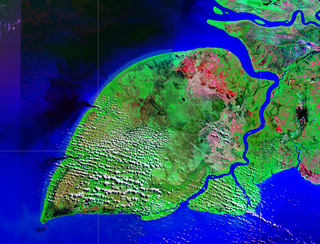
Pulau Yos Sudarso or Pulau Dolok is an island separated only by the narrow Muli Strait from the main island of New Guinea. It is part of the Merauke Regency, in the Indonesian province of South Papua. The island is leaf-shaped, about 165 km (103 mi) long with an area of 11,740 km2 (4,530 sq mi). It was known as Frederik Hendrik Island until 1963. Local and alternative names of the island include Dolok, Kimaam and Kolepom.

Western New Guinea, also known as Papua, Indonesian New Guinea, Indonesian Papua, West Papua New Guinea, is the western, Indonesian half of the island of New Guinea. Since the island is alternatively named as Papua, the region is also called West Papua.

The Asmat are an ethnic group of New Guinea, residing in the province of South Papua, Indonesia. The Asmat inhabit a region on the island's southwestern coast bordering the Arafura Sea, with lands totaling approximately 18,000 km2 (7,336 mi2) and consisting of mangrove, tidal swamp, freshwater swamp, and lowland rainforest.
The Kombai are a Papuan people living in the Indonesian province of South Papua, more specifically in Mappi Regency. Their total population is about 5,650.
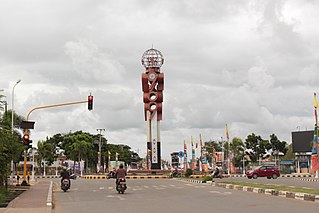
Merauke, also known as the District of Merauke, is a large town in South Papua, Indonesia. It is also the administrative centre of Merauke Regency. It is considered the easternmost city in Indonesia. The town was originally called Ermasoe. It is next to the Maro River where the Port of Merauke is located. As of the 2010 census, Merauke had a population of 87,634 which at the 2020 Census had increased to 102,351.

The Marind or Marind-Anim are an ethnic group of New Guinea, residing in the province of South Papua, Indonesia.

Christmas in Indonesia, locally known as Natal from the Portuguese word for Christmas, is celebrated with various traditions throughout the country.

The Bulaka River languages are a pair of closely related Papuan languages, Yelmek and Maklew, on the Bulaka River in Indonesian West Papua. They are ethnically Yab (Jab); their speech is Yabga (Jabga).

The Yam languages, also known as the Morehead River languages, are a family of Papuan languages. They include many of the languages south and west of the Fly River in Papua New Guinea and Indonesian West Papua.
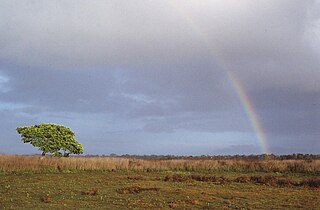
The Wasur National Park forms part of the largest wetland in Merauke Regency, South Papua, Indonesia and has been one of the least disturbed by human activity. The high value of its biodiversity has led to the park being dubbed the "Serengeti of Papua". The vast open wetland, in particular Rawa Biru Lake, attracts a very rich fauna.

Morori is a moribund Papuan language of the Kolopom branch of the Trans–New Guinea family. It is separated from the other Kolopom languages by the intrusive Marind family. All speakers use Papuan Malay or Indonesian as L2, and many know Marind.
Maklew is a language of the proposed Trans-Fly – Bulaka River family in West Papua. It is known to be spoken in Welbuti village, Merauke Regency. It is thought to be closely related to the Yelmek Language.
The Brazza River is a river in Papua province, Indonesia. The Brazza River has its source at over 3000 meters of elevation in the Jayawijaya or Maoke Mountains of central Papua in Yahukimo Regency, and flows south to the lowland rainforests of Asmat Regency before meeting the Pulau River, which flows southeast to the Arafura Sea.
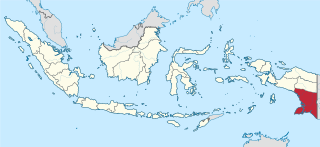
South Papua, officially the South Papua Province, is an Indonesian province located in the southern portion of Papua, following the borders of Papuan customary region of Anim Ha. Formally established on 11 November 2022 and including the four most southern regencies that were previously part of the province of Papua and before 11 December 2002 were all part of a larger Merauke Regency, it covers an area of 117,849.16 km2. It had a population of 522,215 according to the official estimates for mid 2022, making it the least populous province in Indonesia.
Proto-Trans–New Guinea is the reconstructed proto-language ancestral to the Trans–New Guinea languages. Reconstructions have been proposed by Malcolm Ross and Andrew Pawley.
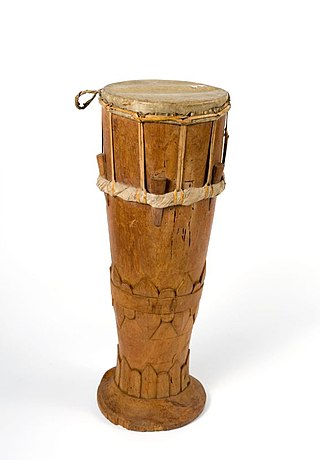
The tifa, tiwa or tiva is a single-headed goblet drum used throughout the Maluku Islands of Eastern Indonesia, where it is traditionally the "dominant instrument" in Maluku province music. The term tifa has been used outside of the Maluku Islands, including on the island of Java and on the island of New Guinea, in Indonesia's Papua province.

Highland Papua is a province of Indonesia, which roughly follows the borders of Papuan customary region of Lano-Pago, shortened to La Pago. It covers an area of 51,213.34 km2 (19,773.58 sq mi) and had a population of 1,430,459 according to the official estimates as at mid 2022.